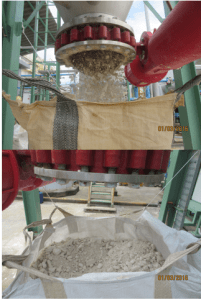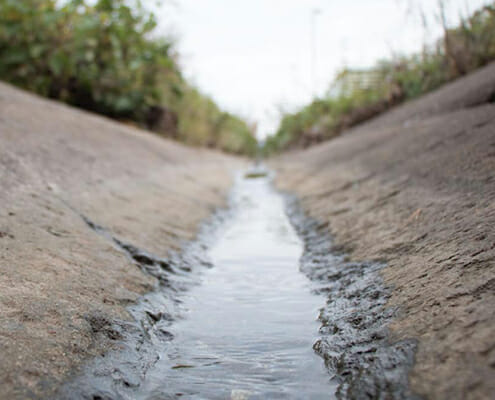The Role of Filtration in Water Conservation
Water has become a scarce product in many parts of the World. Once an abundantly available resource, supply is running low and demand both for private and industrial use has constantly increased over the years. While historically we have never given too much attention to conservation of this valuable product, we today find ourselves increasingly fighting for a larger share of what lies to our disposal. In certain regions of China for example, the maximum amount of water usage is specified inside licenses for new production plants. As the size of the plant is hence defined by its water usage, the process technology which uses the least amount of water will also allow for the largest plant to be built within the given license agreement.
As a result water conservation is playing a more dominant role in today’s decision making process. International process licensors and engineering companies are finding themselves adapting their designs to the local water usage regulations. Obviously, solid/liquid separation equipment play an important role in these processes. These can generally be categorized into:
- Feed water treatment
- Conservation and reuse of water
- Product recycling from waste water streams
- Process water recovery
As production plants usually have life cycles of a few decades we often find ourselves confronted with older process technologies, despite the fact that many plants have gone through revamping stages to modernize their equipment. The following paragraphs describe a number of cases where filtration technology had a major impact in the above categories. For space reasons, only some among the presented examples are described in more detail.
Feed water treatment
Sea water pretreatment prior reverse osmosis desalination
In coastal areas where sea water is available freely but potable or even utility water is a precious resource (e.g. Middle East), desalination by means of RO is a very common approach.
RO membranes are very susceptible to even low concentrations of suspended solids, therefore a pre-treatment is required in order to protect the membranes from fouling or contamination and extend their lifetime, respectively reduce the maintenance shut-down time. A special mention is needed for algae removal, among the most challenging tasks in such an application: algae proliferate unpredictably depending on sea water temperature and their colloidal behavior represents in general a serious challenge for filtration systems.
Conventional pre-treatment systems may include flocculant dosing, multi media (gravel-sand-anthracite) filtration, cross-flow filtration, just to name a few. An equipment such as the FUNDABAC® filter can replace a complete treatment system capable of removing virtually all suspended matters down to sub-micron levels.
DrM filters operating with filter aid can successfully deal with algae and other suspended solids present in sea water by removing them on a quantitative basis and producing water ideally suited to be processed by RO plants.
Conservation and reuse of water
- Pre- and Postleach operations in TiO2 production
- Produced water filtration
In Produced Water handling filters are installed downstream of the slug catcher or flash drum. During normal operation the water coming from the flash drum is processed, while on an intermittent basis various other process streams are treated, such as wash water or pigging water. Metal sulphates, FeS, free mercury and sand are among the solids to be removed. The amount of solids generated by the system and their tendency to foul increases dramatically during intermittent operations like pipeline pigging. Due to the possibility of using filter aid when confronted with reduced filterability, DrM filters can flexibly adapt to a very wide range of operating conditions.
With its fully enclosed design, the FUNDABAC® easily fulfills HSE requirements when dealing with hazardous substances (Hg, H2S, NORMs) typically present in well formation water.
Product recycling from waste water streams
- Recovery of ABS from a waste water stream in ABS production
- Recovery of terephtalic acid in PTA plants
PTA crystals are large and fast filtering solids and concentration in the mother liquor after crystallization is relatively high. Recovery is done on centrifuges or rotary pressure filters.
However, while cooling the filtrate additional PTA is precipitated in considerable amounts and this would be lost in the waste stream if no treatment was to follow. Additionally, the organic load in the waste water stream would significantly contribute to the COD level downstream in the biological treatment system.
The FUNDABAC® filter contributes significantly in reducing organic waste and increasing yields by up to 2% in PTA plants globally.
Process water recovery
- CaSO4 removal in Chlor Alkali processes
- Absorption column wash water filtration
Absorption columns for gas treatment is widely applied as an effective means to remove contaminants. Typically, also solids are removed and accumulate in the wash water. Since many years the FUNDABAC® has played a major role in removing such solid contaminants from absorption liquids in coal fired power plants, waste incineration plants and refineries (H2S removal).
- Treatment of flushing water of electrostatic filter
Electrostatic filters applied in flue gas treatment processes need to be flushed regularly for regeneration. Without an appropriate solid/liquid treatment system the used flush water would have to be rejected, producing significant amounts of waste. The FUNDABAC® was proven ideal for this application and allows for a closed loop design in unmanned operations, virtually eliminating liquid waste.
- Waste water recycling in PVC production
Waste water in PVC plants cannot be recycled unless COD is reduced and solids removed completely. The FUNDABAC® filter offers an elegant solution to take care of this stream.
Silicon removal from grinding and shaping operations in chip manufacturing
…and many others
DrM, Dr. Mueller AG is a world-leading supplier of solid-liquid separation systems established in Switzerland since 1982. Over 3’000 filtration units are installed worldwide to date, successfully operating on hundreds of industrial applications. What is presented above is therefore just a small selection of cases where DrM candle filters have been successfully deployed.
DrM’s core products are FUNDABAC® and CONTIBAC® candle filters, sophisticated systems capable of removing suspended solids down to 1 µm or less from liquid streams. As shown in the pictures below, vertical filtration elements (candles) are installed inside a pressure vessel and a textile filter cloth is fit around each candle by means of a simple, circular fixation clamp which dramatically minimizes potential for leakage with respect to competitive designs.
DrM filters work fully automatic and do not need operator intervention. Additionally, due to the absence of rotating or otherwise moving parts, maintenance is simple and limited to a few inexpensive items: routine maintenance only consists in the periodic (yearly) replacement of filter cloths. These can be selected among over 50 different types in order to finely adapt to the very specific requirements of each and every application.
The special proprietary design of DrM candles provides FUNDABAC® filters with the unique capability of discharging filtered solids as a 50-80% dry cake, thus minimizing the amount of waste to be disposed of.

